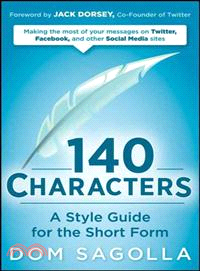140 CHARACTERS: A STYLE GUIDE FOR THE SHORT FORM
商品資訊
ISBN13:9780470556139
出版社:JOHN WILEY & SONS;LTD
作者:SAGOLLA
出版日:2009/09/21
裝訂/頁數:平裝/208頁
商品簡介
作者簡介
目次
相關商品
商品簡介
Make the most of your messages on Twitter, Facebook, and other social networking sites
The advent of Twitter and other social networking sites, as well as the popularity of text messaging, have made short-form communication an everyday reality. But expressing yourself clearly in short bursts-particularly in the 140-character limit of Twitter-takes special writing skill.
In 140 Characters, Twitter co-creator Dom Sagolla covers all the basics of great short-form writing, including the importance of communicating with simplicity, honesty, and humor. For marketers and business owners, social media is an increasingly important avenue for promoting a business-this is the first writing guide specifically dedicated to communicating with the succinctness and clarity that the Internet age demands.
Covers basic grammar rules for short-form writing
The equivalent of Strunk and White's Elements of Style for today's social media-driven marketing messages
Helps you develop your own unique short-form writing style
140 Characters is a much-needed guide to the kind of communication that can make or break a reputation online.
The advent of Twitter and other social networking sites, as well as the popularity of text messaging, have made short-form communication an everyday reality. But expressing yourself clearly in short bursts-particularly in the 140-character limit of Twitter-takes special writing skill.
In 140 Characters, Twitter co-creator Dom Sagolla covers all the basics of great short-form writing, including the importance of communicating with simplicity, honesty, and humor. For marketers and business owners, social media is an increasingly important avenue for promoting a business-this is the first writing guide specifically dedicated to communicating with the succinctness and clarity that the Internet age demands.
Covers basic grammar rules for short-form writing
The equivalent of Strunk and White's Elements of Style for today's social media-driven marketing messages
Helps you develop your own unique short-form writing style
140 Characters is a much-needed guide to the kind of communication that can make or break a reputation online.
作者簡介
DOM SAGOLLA helped create Twitter with Jack Dorsey and a team of entrepreneurs in San Francisco. He also helped engineer Macromedia Studio, Odeo, and Adobe Creative Suite, and now produces iPhone applications with his company, DollarApp.
目次
Acknowledgments.
Foreword by Jack Dorsey.
Introduction.
The Short Form.
The History of Twitter.
Part One: LEAD.
Chapter 1. Describe: A Brief Digression to Discuss Journalism Is Warranted.
Observe the Truth.
Play with Perspective.
Lead with Action.
Chapter 2. Simplify: Say More with Less.
Constrain Yourself to the Atomic Unit of One Message.
Appreciate Craftsmanship as a Thousand Small Gestures.
Start Small and Serve a Special Niche.
Limit Yourself to One Sentence, One Thought.
Chapter 3. Avoid: Don't Become a Fable about Too Much Information.
Remember What Not to Do.
Find Your Lowest Common Denominator.
Divine a Strategy against Too Much Information.
Practice Self-Defense.
Part Two: VALUE.
Chapter 4. Voice: Say It Out Loud.
Extend Your Range.
Build Your Repertoire.
Strengthen and Amplify.
Chapter 5. Reach: Understand Your Audience.
Measure Reader Engagement.
Gauge the Reaction to Your Message.
Identify Your Fans.
Chapter 6. Repeat: It Worked for Shakespeare.
Enable Repetition of Your Message.
Repeat the Words of Others, Adding Your Mark in the Process.
Exploit the Twitter Effect.
Chapter 7. Mention: Stamp Your Own Currency.
Design Your Mark.
120 is the New 140.
Post One or Two Replies, Then Take It Offline.
Chapter 8. Dial: Search for Silence, Volume, and Frequency.
Pipe Up Just When It's Quiet.
Understand the Use of CAPITALS.
Discover Your “Office Hours”.
Chapter 9. Link: Deduce the Nature of Short Messages.
Study the Anatomy of a Single Message.
Share the Power of Hypertext.
Change the Meaning of Words by Linking Them.
Chapter 10. Word: Expose the Possibilities in Phraseology, Poetry, and Invention.
Design Your Own Pattern
Build Your Own Lexicon by Inventing New Words.
Poetry Is a Guide.
Part Three: MASTER.
Chapter 11. Tame: Apply Multiple Techniques Toward the Same End.
Technology Will Consume Us If We Don’t Learn to Control It.
Discover the Antidote to Each of 12 Stages.
Manage Multiple Accounts Effectively.
Remember: It's All about Timing.
Chapter 12. Cultivate: Meet 140 Characters, Each with a Unique Story.
Create a Culture of Fun.
Imagine Your Audience.
Focus on Learning.
Chapter 13. Branch: Steady, Organic Growth Is Most Manageable.
Don't Let Success Go to Your Head.
Do the Same Thing, but Differently.
Never Stop.
Part Four: EVOLVE.
Chapter 14. Filter: Teach the Machine to Think Ahead.
A Little Programming Goes a Long Way.
Breaking Things Is a Path to Learning.
Chapter 15. Open: Give and You Shall Receive.
Go Positive.
Never Limit Yourself to One Platform.
Chapter 16. Imitate: There Is Nothing Original, Except in Arrangement.
Become an Apprentice.
Take Someone Else's Style One Step Further.
Create a Caricature of Yourself.
Chapter 17. Iterate: Practice a Sequence of Tiny Adjustments.
Write Everywhere and Often.
Games for Words.
Ignite Change.
Part Five: ACCELERATE.
Chapter 18. Increase: Do More.
Produce a Series on a Short Subject.
Manufacture Velocity.
Exceed Constraints.
Chapter 19. Fragment: Do It Smaller.
Decrease the Size of the Atomic Unit, the Message.
Embrace Ambiguity.
Recommended Reading.
Glossary.
Index.
Foreword by Jack Dorsey.
Introduction.
The Short Form.
The History of Twitter.
Part One: LEAD.
Chapter 1. Describe: A Brief Digression to Discuss Journalism Is Warranted.
Observe the Truth.
Play with Perspective.
Lead with Action.
Chapter 2. Simplify: Say More with Less.
Constrain Yourself to the Atomic Unit of One Message.
Appreciate Craftsmanship as a Thousand Small Gestures.
Start Small and Serve a Special Niche.
Limit Yourself to One Sentence, One Thought.
Chapter 3. Avoid: Don't Become a Fable about Too Much Information.
Remember What Not to Do.
Find Your Lowest Common Denominator.
Divine a Strategy against Too Much Information.
Practice Self-Defense.
Part Two: VALUE.
Chapter 4. Voice: Say It Out Loud.
Extend Your Range.
Build Your Repertoire.
Strengthen and Amplify.
Chapter 5. Reach: Understand Your Audience.
Measure Reader Engagement.
Gauge the Reaction to Your Message.
Identify Your Fans.
Chapter 6. Repeat: It Worked for Shakespeare.
Enable Repetition of Your Message.
Repeat the Words of Others, Adding Your Mark in the Process.
Exploit the Twitter Effect.
Chapter 7. Mention: Stamp Your Own Currency.
Design Your Mark.
120 is the New 140.
Post One or Two Replies, Then Take It Offline.
Chapter 8. Dial: Search for Silence, Volume, and Frequency.
Pipe Up Just When It's Quiet.
Understand the Use of CAPITALS.
Discover Your “Office Hours”.
Chapter 9. Link: Deduce the Nature of Short Messages.
Study the Anatomy of a Single Message.
Share the Power of Hypertext.
Change the Meaning of Words by Linking Them.
Chapter 10. Word: Expose the Possibilities in Phraseology, Poetry, and Invention.
Design Your Own Pattern
Build Your Own Lexicon by Inventing New Words.
Poetry Is a Guide.
Part Three: MASTER.
Chapter 11. Tame: Apply Multiple Techniques Toward the Same End.
Technology Will Consume Us If We Don’t Learn to Control It.
Discover the Antidote to Each of 12 Stages.
Manage Multiple Accounts Effectively.
Remember: It's All about Timing.
Chapter 12. Cultivate: Meet 140 Characters, Each with a Unique Story.
Create a Culture of Fun.
Imagine Your Audience.
Focus on Learning.
Chapter 13. Branch: Steady, Organic Growth Is Most Manageable.
Don't Let Success Go to Your Head.
Do the Same Thing, but Differently.
Never Stop.
Part Four: EVOLVE.
Chapter 14. Filter: Teach the Machine to Think Ahead.
A Little Programming Goes a Long Way.
Breaking Things Is a Path to Learning.
Chapter 15. Open: Give and You Shall Receive.
Go Positive.
Never Limit Yourself to One Platform.
Chapter 16. Imitate: There Is Nothing Original, Except in Arrangement.
Become an Apprentice.
Take Someone Else's Style One Step Further.
Create a Caricature of Yourself.
Chapter 17. Iterate: Practice a Sequence of Tiny Adjustments.
Write Everywhere and Often.
Games for Words.
Ignite Change.
Part Five: ACCELERATE.
Chapter 18. Increase: Do More.
Produce a Series on a Short Subject.
Manufacture Velocity.
Exceed Constraints.
Chapter 19. Fragment: Do It Smaller.
Decrease the Size of the Atomic Unit, the Message.
Embrace Ambiguity.
Recommended Reading.
Glossary.
Index.
主題書展
更多
主題書展
更多書展今日66折
您曾經瀏覽過的商品
購物須知
外文書商品之書封,為出版社提供之樣本。實際出貨商品,以出版社所提供之現有版本為主。部份書籍,因出版社供應狀況特殊,匯率將依實際狀況做調整。
無庫存之商品,在您完成訂單程序之後,將以空運的方式為你下單調貨。為了縮短等待的時間,建議您將外文書與其他商品分開下單,以獲得最快的取貨速度,平均調貨時間為1~2個月。
為了保護您的權益,「三民網路書店」提供會員七日商品鑑賞期(收到商品為起始日)。
若要辦理退貨,請在商品鑑賞期內寄回,且商品必須是全新狀態與完整包裝(商品、附件、發票、隨貨贈品等)否則恕不接受退貨。
























